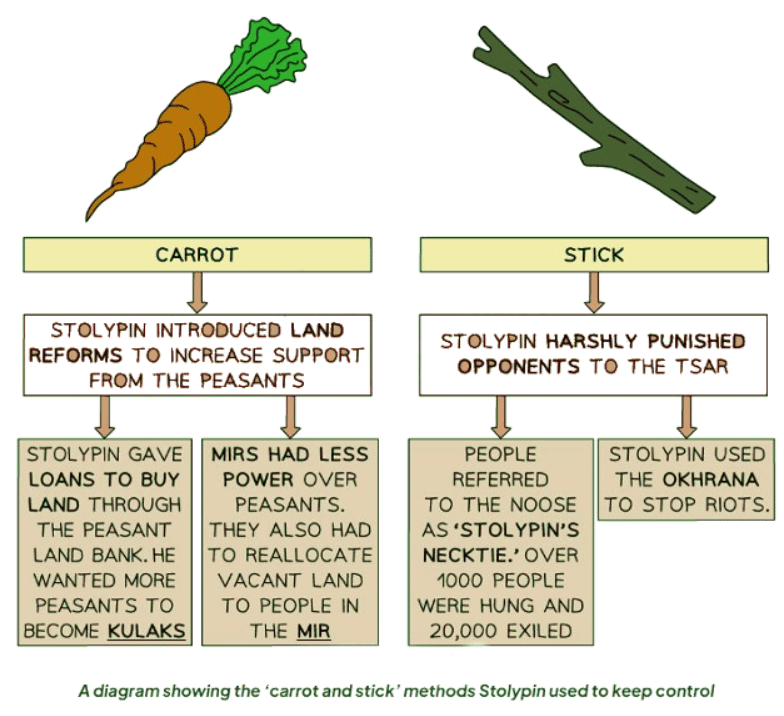Class 10 Exam > Class 10 Notes > History for GCSE/IGCSE > How Did the Tsar Survive the 1905 Revolution?
How Did the Tsar Survive the 1905 Revolution? | History for GCSE/IGCSE - Class 10 PDF Download
Why was 1905 a Turning Point in Tsarist Russia - Timeline & Summary

The events of 1905 highlighted the weakness of the tsarist regime because:
- Japan defeated Russia in the war. The tsar believed the Japanese were an inferior race to the Russians. The defeat showed that Russia was no longer a strong military power.
- The tsar could no longer rely on the divine right of kings. A growth in radical ideas and a decline in the influence of the Orthodox Church weakened the tsar. Tsar Nicholas II could no longer expect his people to obey him.
- The tsar had to reform. Russian tsars used repression to resist reform. However, in 1905, Nicholas could not rely on his military forces. The strength of opposition to the tsar from multiple areas of society pushed Nicholas to provide some democratic reform. When Nicholas attempted to reverse these reforms later, he was unable to.
- Many historians call this period a revolution, even though it did not result in the overthrow of the tsar. This shows the amount of popular opposition to the tsar and the threat it posed to Tsarist Russia.
Causes of the 1905 Revolution

Events of the 1905 Revolution

How Did Tsar Nicholas II Survive the 1905 Revolution?
- Nicholas employed a mix of reforms and repression to maintain authority over the Russian Empire

The October Manifesto and the Fundamental Laws
October Manifesto
- Witte, the Russian prime minister, convinced Nicholas to enact the October Manifesto which pledged:
- An elected duma (parliament) where laws could be passed
- Enhanced political rights for Russian citizens
- A commitment to relax censorship laws
- Freedom of speech and assembly
- A restructuring of the government system with the Tsar remaining the head, advised by the Council of Ministers
- The State Council's appointment by the Tsar and the zemstva
- Universal male suffrage for duma representatives
- Varying reactions from the populace to the October Manifesto

The Fundamental Laws
- In 1906, Tsar Nicholas introduced the Fundamental Laws, which upheld the reforms outlined in the October Manifesto.
- These laws reaffirmed Nicholas's authority as the tsar, showcasing his reluctance to relinquish his autocratic powers.

The Establishment of the Duma
- The Tsar permitted the formation of four dumas during the period spanning 1906 to 1914.
Election Results for the Duma

- Performance of Different Dumas:
- The initial two dumas expressed radical views, urging the tsar to implement further reforms.
- Nicholas promptly dissolved these dumas in response to their demands.
- The subsequent third and fourth dumas were comparatively feeble.
- Government Interventions:
- Changes in voting regulations were made to curtail the influence of peasant voters.
- The alterations aimed to amplify the representation of right-wing political factions in the duma.
- These actions underscored the tsar's ambivalence towards democratizing Russia.
- The tsar missed an opportunity to transform Russia into a constitutional monarchy by rendering the duma impotent.
Question for How Did the Tsar Survive the 1905 Revolution?Try yourself: What was one of the factors that highlighted the weakness of the tsarist regime in 1905?View Solution
Peter Stolypin
- Tsar Nicholas appointed Peter Stolypin as Prime Minister in 1906, showcasing the 'carrot and stick' strategy employed by the tsar to exert control over Russia.

- Despite the implementation of these strategies, historians argue that the long-term effectiveness was limited.
- The number of kulaks, a wealthy class of peasants, remained minimal.
- Impoverished peasants experienced further economic hardships.
- Laborers continued to endure unfavorable working conditions.
- Wages post the 1905 Revolution were lower compared to 1903 levels.
- The year 1912 witnessed strikes at the Lena Goldfields, which were met with severe government suppression.
The document How Did the Tsar Survive the 1905 Revolution? | History for GCSE/IGCSE - Class 10 is a part of the Class 10 Course History for GCSE/IGCSE.
All you need of Class 10 at this link: Class 10
|
81 videos|88 docs|18 tests
|
FAQs on How Did the Tsar Survive the 1905 Revolution? - History for GCSE/IGCSE - Class 10
| 1. Why was 1905 considered a turning point in Tsarist Russia? |  |
Ans. 1905 was considered a turning point in Tsarist Russia because it marked the beginning of significant political and social change in the country. The 1905 Revolution highlighted the discontent among the Russian population and forced the Tsar to make concessions, such as the establishment of the Duma and the issuance of the October Manifesto.
| 2. What were the causes of the 1905 Revolution in Tsarist Russia? |  |
Ans. The causes of the 1905 Revolution in Tsarist Russia included economic hardship, political repression, social inequality, and dissatisfaction with the Tsarist regime. The Russo-Japanese War and the Bloody Sunday massacre also contributed to the growing unrest among the Russian population.
| 3. What were the key events of the 1905 Revolution in Tsarist Russia? |  |
Ans. The key events of the 1905 Revolution in Tsarist Russia included the Bloody Sunday massacre, the general strike of October 1905, and the formation of the first soviet in St. Petersburg. These events culminated in the Tsar issuing the October Manifesto, which promised civil liberties and the establishment of a legislative Duma.
| 4. How did the Tsar survive the 1905 Revolution in Russia? |  |
Ans. The Tsar survived the 1905 Revolution in Russia by issuing the October Manifesto, which promised civil liberties and the establishment of a legislative Duma. He also implemented reforms under Prime Minister Stolypin, such as land reforms and the suppression of revolutionary movements.
| 5. What was the significance of the Establishment of the Duma in Tsarist Russia after the 1905 Revolution? |  |
Ans. The establishment of the Duma in Tsarist Russia after the 1905 Revolution marked a significant step towards constitutional monarchy in the country. The Duma provided a platform for political representation and debate, although its powers were limited by the Fundamental Laws and the Tsar's control.
Related Searches















